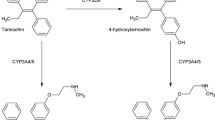Abstract
Tamoxifen binding sites (TBS) were measured using3H-tamoxifen, the objective being to evaluate the relationships among TBS and hormone receptors and/or clinical and pathological characteristics in malignant tissues from 60 patients with mammary cancer. TBS were detected in most (96.7 per cent) cancers in the breast tissues, and the mean content and affinity were 569 fmole/mg protein with Kd: 1.98 nM. There was no significant correlation between TBS and the estrogen receptor and/or progesterone receptor, with respect to positivity or content. However, there was a significant correlation between TBS and histological grading, thereby indicating the differentiation and the proliferative activity in this tissue. The content of TBS was significantly higher in the group with a high grade of malignancy. The TBS content significantly increased in parallel with the degree of malignancy, as related to tubule formation, nuclear pleomorphism and mitotic activity. On the other hand, there was no significant correlation between TBS and age, tumor size, lymphnode status or clinical stage. These results suggest the possibility that TBS may be associated with differentiation and cell-proliferation in breast cancer tissues.
Similar content being viewed by others
References
Lippman ME, Bolan G, Huff K. The effects of estrogens and antiestrogens on hormone-responsive human breast cancer in long-term tissue culture. Cancer Res 1976; 36: 4595–4601.
Eckert RL, Katzenellenbogen BS. Effects of estrogens and antiestrogens on estrogen receptor dynamics and the induction of progesterone receptor in MCF-7 human breast cancer cells. Cancer Res 1982; 42: 139–144.
Coezy E, Borgna JL, Rochefort H. Tamoxifen and metabolites in MCF-7 cells: correlation between binding to estrogen receptors and inhibition of cell growth. Cancer Res 1982; 42: 317–323.
Sutherland RL, Foo MS. Differential binding of antiestrogens by rat uterine and chick oviduct cytosol. Biochem Biophys Res Commun 1979; 91: 187–191.
Sutherland RL, Murphy LC, Foo MS, Green MD, Whybourne MA. High-affinity antiestrogen binding site distinct from the oestrogen receptor. Nature 1980; 288: 273–275.
Faye JC, Lasserre B, Bayard F. Antiestrogen specific, high affinity saturable binding sites in rat uterine cytosol. Biochem Biophys Res Commun 1980; 93: 1225–1231.
Gulino A, Pasqualini JR. Heterogeneity of binding sites for tamoxifen and tamoxifen derivaties in estrogen target and non target fetal organs of guinea pig. Cancer Res 1982; 42: 1913–1921.
Sudo K, Monsma F, Katzenellenbogen B. Antiestrogen-binding sites distinct from the estrogen receptor: subcellular localization, ligand specificity and distribution in tissues of the rat. Endocrinology 1982; 112: 425–434.
Miller MA, Katzenellenbogen BS. Characterization and quantitation of antiestrogen binding sites in estrogen receptor-positive and negative human breast cancer cell lines. Cancer Res 1983; 43: 3094–3100.
Kon OL. An antiestrogen binding protein in human tissues. J Biol Chem 1983; 258: 3173–3177.
Chouvet C, Saez S. High affinity cytosol binding sites for antiestrogens in two human breast cancer cell lines and in biopsy specimens devoid of estrogen receptors. J Steroid Biochem 1984; 21: 755–761.
Brandes LJ. A diphenylmethane derivative selective for the anti-estrogen binding site may help define its biological role. Biochem Biophys Res Commun 1984; 124: 244–249.
Brandes LJ, Macdonald LM, Bogdanovic RP. Evidence that the antiestrogen binding site is a histamine or histamine-like receptor. Biochem Biophys Res Commun 1985; 126: 905–910.
Nishimura R, Misumi A, Kimura M, Tokunaga T, Akagi M. Relationship between the content of estrogen and progesterone receptors and the pathological characteristics in human breast cancer. Jpn J Surg 1982; 12: 191–197.
Nishimura R, Kimura M, Tokunaga T, Akagi M. Measurement of nuclear estrogen receptors by charcoal adsorption: relationships of cytoplasmic and nuclear estrogen receptors and progesterone receptors in human breast cancer. Gann 1982; 73: 713–720.
Scatchard G. The attraction of proteins for small molecules and ions. Ann NY Acad Sci 1949; 51: 660–672.
Lowry OH, Rosebrough NJ, Farr AL, Randall RJ. Protein measurement with the folin reagent. J Biol Chem 1951; 193: 265–275.
Japan Mammary Cancer Society, General Rules for Clinical and Pathological Record of Mammary Cancer, 5th Edition, Tokyo: Kanehara, 1979: 23–41.
Bloom HJG, Richardson WW. Histological grading and prognosis in breast cancer. Br J Cancer 1957; 11: 359–369.
Araki K, Kimura M, Sakamoto K, Nishimura R, Yamashita J, Akagi M. Sequential assays of hormone receptors and the tritiated thymidine labeling index in 7,12-Dimethylbenz(a)anthracene-induced rat mammary cancers. Jpn J Surg 1985; 15: 150–159.
Araki K, Kimura M, Sakamoto K, Nishimura R, Akagi M. Significance of the tritiated thymidine labeling index in breast cancers. Jpn J Surg 1985; 15: 144–149.
Kahlson G, Rosengren E. In: Blum JJ ed. Biogenic Amines as Physiological Regulators. Prentice-Hall, Englewood Cliffs, NJ. 1970; 223–238.
Kahlson G, Rosengren E, Steinhardt C. Activation of histidine decarboxylase in tumor cells in mice. Nature (Lond) 1962; 194: 380–381.
Kahlson G. Proc Int Union Physiol Congr Leiden 1962; 1: 856–862.
Author information
Authors and Affiliations
Rights and permissions
About this article
Cite this article
Fujino, N., Kimura, M., Sakamoto, K. et al. Tamoxifen binding sites in human mammary cancers. The Japanese Journal of Surgery 16, 311–317 (1986). https://doi.org/10.1007/BF02470552
Received:
Issue Date:
DOI: https://doi.org/10.1007/BF02470552




